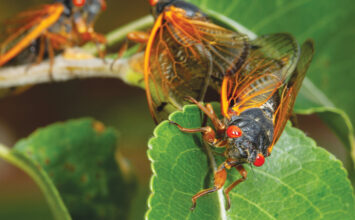A fleeting moment in the sun
 By DAN ZARLENGA
By DAN ZARLENGA
Missouri Department of Conservation
You may have heard a lot about cicadas lately. In fact, you may even be hearing a lot of cicadas right now. Some people say they’re ugly, gross, annoying. They call their sounds loud, irritating, and bizarre. They get frustrated to find the bugs covering their trees, deck posts, and fences. Their dogs throw up from eating too many of them. What a traumatic experience!
Yet, all these harmless insects want, is a day in the sun.
EMERGENCE YEAR
2024 is an emergence year for periodical cicada Brood XIX (19). Periodical cicadas, the ones we’re seeing this spring, differ from the annual cicadas we encounter every July and August. While related, periodicals have a very different life history. Instead of coming out in moderate numbers every summer, the survival strategy of these cicadas is to break out in overwhelming droves once every 13 years.
The story of the cicadas we see and hear now actually began in 2011, the year they hatched. It was the same year the Toyota Prius hybrid first hit the scene. The iPhone 4 was introduced, and Siri was born. These cicadas have existed in darkness since then.
THE CICADA LIFE CYCLE
Once their parents emerged from the ground 13 years ago, they climbed vertical structures like trees and deck posts to shed their exoskeleton. These resembled white, empty bug shells. From here, the new adult cicadas took about four to six days before their wings were fully developed.
Over the next four to six weeks, male periodical cicadas congregated in groups called “choruses”, usually in high, sunlit tree branches. They created raspy songs by vibrating a pair of ridged membranes on the sides of their bodies called tymbals. The collective drone of these choruses could be deafening.
All this was to attract females. After mating, the females made small slits in tree branches in which to lay 400-600 eggs. The eggs hatched into nymphs; those nymphs fell to the ground and burrowed into the soil.
A LONG TIME UNDERGROUND
For more than three U.S. presidential terms, the cicada nymphs fed underground on fluids gleaned from small tree roots. Over a decade went by as the nymphs lived buried in darkness, cut off from the sensations of sun and open air. Children preparing to enter kindergarten when these cicadas hatched would be graduating high school before these insects could see the light of day again.
Then after 13 genetically regulated years, the periodical cicadas’ evolutionary alarm clocks prompted them to tunnel to the surface again. Today we see and hear this cohort of cicadas repeating the same generational cycle their parents lived more than a decade ago.
LITTLE TIME IN THE SUN
The little time these insects are granted above ground is precious. It’s just a half percent of the cicada’s entire 13-year lifespan. A magnificent instant to live in the light of day, fly through the springtime air, sing, mate, and fulfill the purpose of their existence. The final winged and free stage of their lives lasts a mere few weeks, affording the cicadas a brief chance to create a new generation. And then they’ll be gone. Their offspring will not fulfill the next cycle until 2037.
So, when you see and hear these loud, odd looking, orange-eyed insects, please excuse the noise and inconvenience. It’s their fleeting, final moment to shine in sun.



Leave a Reply